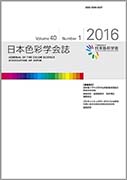An experiment was conducted in which twenty-four female university students were instructed to judge the preference of the displayed color combination samples and to select the reasons for their preference from a list.
Two analyses were executed using the obtained data, to clarify: (1) the accuracy of the preference prediction using the data on reasons for the reference, and (2) the accuracy of the preference prediction using formulas that show the conditions that the subjects recognize as the reasons, using three attributes of composite colors.
The correlation coefficient between the preference values and the prediction values of preferences was very large, 0.97. This shows efficacy of the new concept of prediction conducted in Analysis 1. According to Analysis 2, the correlation between the preference average value and the prediction value calculated with the formulas that intended to express the conditions that more than six subjects recognized as the reason, using three attributes of the colors of the samples, was 0.72.
View full abstract
